You know the drill, you’re in bed, covers pulled up, and you start to drift off to a wonderful dream. Then your cat starts scratching at your bedroom door or frame. There goes your good night’s sleep right? Or does it have to? Do you want to learn how to stop your cat from keeping you awake? Want to learn how to keep your pets off your counters and furniture? Along with our fellow pet owners, we’ve tried many different ways and found what works.
In this article, you’ll learn 4 proven methods to stop your cat from scratching your bedroom door.
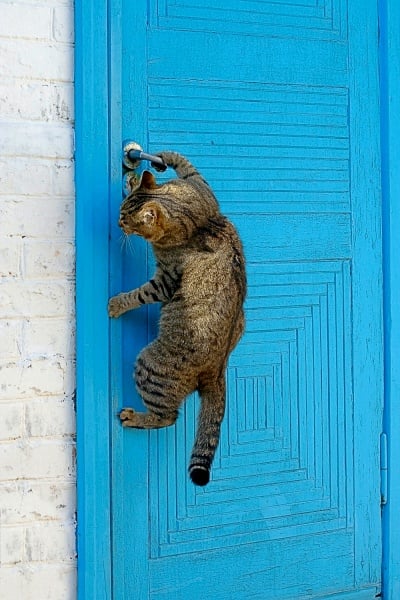
Navigation Tips
You have 5 ways to get the answers you are looking for.
- If you want to learn as much as you can, feel free to read the entire article which starts after the infographic.
- If you have specific questions or topics you are interested in, you can tap or click on the topic heading of your choosing in the Table of Contents which will take you directly to that section..
- If you are a visual learner, you can get the highlights by watching the video below.
- For quick reference, you can view the infographic which is just below the Table of Contents.
- You can use the FAQ section at the end of the article. Click or tap FAQ to go straight to that section.

Table of Contents
Why is my cat scratching my door?
This is an innate behavior. It’s just what cats do. So give them alternatives to your door and furniture. Add some cardboard scratchers or scratch posts around your house. Your cats natural instinct is to use their claws and cat scratchers. Your cat will scratch a standing post or vertical pad, that’s what their claws are for. By providing an outlet, your cat will be less likely to be destroy your furniture, your carpet, and your bedroom door. While they are using the posts to maintain their claws, it’s a good idea to keep their claws trimmed. Use a good quality set of stainless steel clippers with a built-in nail file to give a good nail trim to reduce the need for your cat to maintain their claws themselves.
How do you stop your cat from keeping you awake?
Use the 4 proven methods that we’ve used in our own home and the homes of countless pet parents that we see in our vet clinic:
- Step 1. Don’t reward your cat’s tries
- Step 2. Feed your cat in meals and play with them
- Step 3. Make your bedroom entrance less appealing for your cat
- Step 4. Enrich their environment
Every cat owner should be able to enjoy a healthy, undisturbed sleep at night. Yet as soon as you close the door, your feline friend starts to scratch, purr, and meow all night with an unbelievable intensity. Eventually, it ruins your night. Don’t forget the damage to your home done by this destructive behavior.
The following are affiliate links. As an Amazon Associate I earn from qualifying purchases. This is used for keeping the blog up and running smoothly. Please know this does not change the price you see on Amazon. Thank you for your help and support of PET-Happy!
If you don’t have Amazon Prime, we highly recommend trying it. The biggest benefit is free shipping. Yes, free ! You can also get your orders in 1,2, and even same day along with 2 hour grocery delivery. One of our favorites is the free movies and TV shows on Amazon Prime. There are so many more benefits. To find out yourself, you can try Amazon Prime free for 30 days.
4 Proven Methods
We’ve tried all different ways to accomplish this. We’ve learned what works and what doesn’t. These 4 proven methods will help keep your cat, new kitten, and even your dog away. This will help you sleep without your pet bothering you.
Step 1. Don’t reward your cat’s tries
What do you do when your cat is going crazy when you are trying to fall asleep? Do you let them in? Do you yell or punish in some other way? Do you open a can of their favorite food? Do you toss them french fries to go away (learn can cats eat french fries). Whatever it is: Don’t do it!

The reason is that any attention you give to your cat is in their mind, positive reinforcement. If you give them food or treats after they’ve been ruining your bedroom door, you’ve inadvertently taught them if they engage in attention-seeking behavior, you give them what they wanted, attention. In general, ignoring inappropriate behavior we’ve found is the best way to reduce it.
Your cat isn’t trying to enter the room because they have to be everywhere. (Well, actually they might, but that’s beside the point.) Your cat wants your attention or they may be experiencing separation anxiety. Even if you yell or even if you punish them (please don’t use negative reinforcement like a spray bottle with water in it), it’s still attention. If your cat wants it and gets it, they will repeat what they did. Even if you didn’t mean to, you just taught them that their unwanted behavior will be rewarded.
Which leads us to a conclusion: If you provide any attention, your cat will continue their bad behavior.
Therefore, you should ignore them completely. Within several days, provided you also follow the advice below, your cat will learn that their destructive antics doesn’t result in them getting what they want, they’ll try it less and less.
Step 2. Feed your cat in meals and play with them
There are several benefits to feed your cat in meals on a set feeding schedule. The benefits come when you play with your feline friend for at least several minutes before every meal. The longer you play with your cat before meals, the greater the benefit. This is because playing with your cat ( find out about others here ) is like they are hunting for their meal. This mimics their natural behavior of hunting for their meals. They will expend energy during the playtime. Less energy means less energy for inappropriate behaviors.
Wild felines hunt before they get to eat what they caught. Playing sort of replicates this instinctive behavior. After a meal, cats have to regain the energy spent during the hunt, so they usually go for a nap. If you make meal time similar to your cats natural hunting instincts using different types of toys, they’ll enjoy the mental stimulation more, expend more energy, and sleep deeply afterwards. We found the PetSafe SlimCat interactive toy and food dispenser worked great at this. It’s a ball with an adjustable opening to let out your cats dry kibble as slow as you want. This encourages your cat to play with the it to get their meal. It holds up to 2/3rds of a cup of kibble. Best of all, we toss ours into the dishwasher to keep it clean. We’ve run the three of these that we’ve owned for years through the dishwasher every week or so. They come out clean and stand up to the heat. Just to be safe, make sure to put it on the top shelf (or on the shelf as far away from the heating element as possible). We didn’t do this on our first one and it came out funny shaped. Our cats didn’t care that it was oddly shaped, they still played with it. It also comes in 4 different colors so you could have a different color for each of your cats like we do. This also helped with territory issues during meal times as we could separate our cats with their food toy. With over 23,000 positive reviews, there are many happy kitty cats out there. Best of all, it’s a great way to keep your fur baby at a healthy weight.

If you play with your furry feline friend before every meal, this training technique teaches them how the day works and you’ll enjoy a peaceful night. As cats are creatures of habit, they’ll enjoy the routine.
If you have trouble with your plants getting nibbled on, this interactive toy is a great way for your cat to expend their excess energy.
An additional tip: serve the final meal of the day minutes before you go to sleep. It’s best if your cat finishes when you are already in bed and drifting off to sleep.
Step 3. Make your bedroom entrance less appealing for your cat
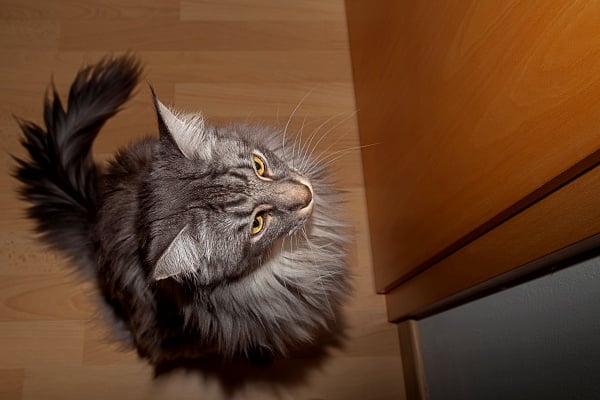
One of the simplest way to stop your cat scratching the door at night is to close the door and place a device called ”sssCat ” on the floor in front of it. What is it? It’s is a motion-activated pet deterrent that releases a burst of air every time anything comes closer.

When your cat approaches your bedroom door, it lets out a small burst of air. Your cat won’t go near that area very soon. What this device provides is consistency of negative reinforcement for unwanted behavior. It doesn’t hurt your pets but they definitely don’t like the puff of air. As a cat owner, you can test this by blowing into your cats face. They just love it don’t they? Just watch for their paw swinging at your face when you do this test. Or you can just take our word for it. We use these throughout our home and veterinary clinic. We can’t live without them. They work exceptionally well in our clinic as we have new pets in all the time. One suggestion: Always have an extra air canister handy. They last quite long, especially once your pets have learned to avoid an area. But they seem to run out at just the wrong moment, so keep an extra ready to go. Extra sssCat Air canisters are available on Amazon.

Best of all, your cat doesn’t associate this negative reaction in any way to you. This preserves your relationship. Pretty soon your cat will understand that the area where you put it isn’t a very friendly location. They won’t even try to approach it.
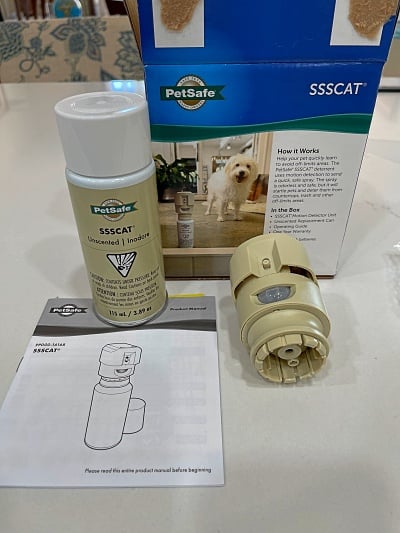
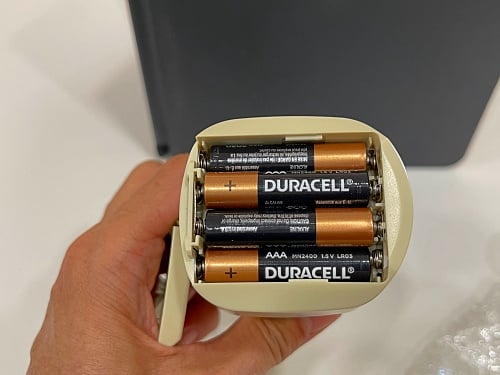
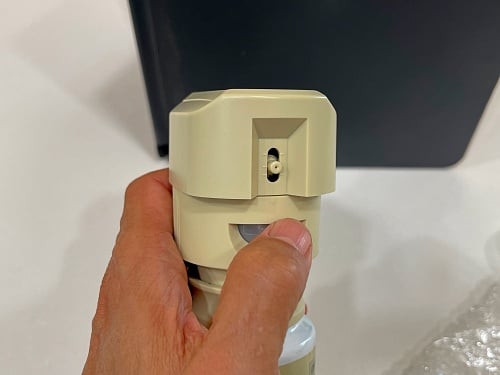
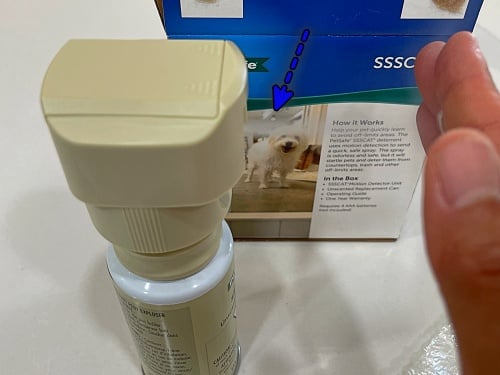
Assembly and demonstration video of sssCat pet deterrent
In the above video, I open a brand new unit that I purchased on Amazon. This was not sponsored, I paid for it just like you would. I show “what’s in the box”, how to assemble the unit, how to adjust the spray head, how to activate it, and demonstrate how it works.
Another thing that many cats don’t like is a mat placed with double-sided tape stuck to the door. Cats don’t like putting their paws on anything sticky. As they won’t get near your door, they won’t be able to scratch, meow, or purr to get your attention. We’ve tried putting tape on doors and unfortunately our cats just ended up screaming because they couldn’t get the tape off their paws. They ended up in a corner, tape all over them, just screaming “help me”. The idea of having one side stuck to the floor to keep it there didn’t work for us. We also tried putting tin foil in front of our door. We found it later shredded. Our cats had a field day with it. A patient recommended bubble wrap, but our cats just ignored it. It didn’t deter them one bit.
What we’ve found works well is the PetSafe ScatMat. It releases a small static shock when your cat (or dog) steps on it. It’s battery operated, comes in several different sizes, and has 3 levels of correction. With a new cat, older cat, or new kitten, start with the lowest setting. Increase it if your cat doesn’t learn that stepping on the mat isn’t the desired behavior. We’ve found our cat and dogs learn very quickly not to go near the mat. The correction doesn’t hurt them, it’s just annoying as they don’t like the funny feeling on the bottom of their paws. We use these at home and at our veterinary clinic too. Keeping our cats off the counters was really tough until we started using these. I purchased a new one that we needed and took some pictures and did a ScatMat What’s In The Box video.

There are also other sizes such as this 30″ x 16″ wide one. The 48″ x 20″ size is their large size. Our outdoor cat needed the highest setting because his paw pads were tougher than our house cats. An adult cat or older cat may also need the higher settings as their pads may be less sensitive than a younger cat. Best of all, the mat can also be used to keep your dog off your couch, chair, and even your bed. We’ve been able to keep our pets off our favorite chairs at home with these. So when we want to relax and watch some TV, we don’t have to fight our pets for our chairs. Even better, we don’t get covered in more pet hair than we already have on us !
You can find more ways to keep your cat out of the bedroom here.
Step 4. Enrich their environment

Even as you try to teach your indoor cat to stay away from the bedroom, make sure you don’t make they miserable and stressed. Like you, most owners keep their cat indoors. A new kitty or existing cat can become stressed by new things in their environment.
Toys: Make sure they have cat toys or other things to entertain them in their part of the house. Especially at night. Add some opportunities for solo play by tossing fake mice and other cat toys around. The Cat Ball Puzzle with 3 levels pictured above is a great source of entertainment for our cats. When we first got the first one, our cats weren’t sure what it was. Then they started playing with it and it was so funny to watch them play with it. They even started fighting a bit to have their turn with it so we ended up buying two. Pro tip: Put them in different parts of the house to keep the peace if you have multiple cats. If your cats aren’t sure about it, put some kibble in the tracks behind the balls and watch the fun ensue. We’ve found that the UPSKY Cat Toy Roller is a great choice to keep our cats entertained. Read our article How to enrich an indoor cats life to find other ways to “catify” your home.
Vertical space: We’re talking about cat trees and perches. Get more than one, and install some shelves on the walls so that your felines can climb, jump, and perch.
How soon will I get results?
How fast do these 4 proven methods work? In most cases, you’ll see some improvement within a few days. Yes, your mileage may vary. Every pet is different and learns at a different pace. If you are consistent (and that’s the hardest part), your pet’s behavior should change after two weeks.
Please remember that even after your efforts, you’ll still need to play with your cat. Keeping them entertained and giving them attention on your terms is key. This will help prevent him or her from waking you up at night again. Follow these 4 methods to get a better nights sleep and you’ll be healthier and happier. Your cat (and dog) will be healthier and happier too.
You have learned how to stop a cat from scratching your door using 4 different methods. This will go a long way towards a loving and happy life with your pet cat. And keeping your Pet Happy is what we all want.
FAQ
Question: Why does my cat scratch the door at night?
Answer: There are several reasons why your cat does this at night. They may be trying to get your attention, be expressing their territorial nature, or trying to mark their territory. Your cat may also scratch the door as a way to relieve stress or boredom.
Question: How can I prevent my cat from this destructive behavior?
Answer: Follow these 4 proven methods. They are: not rewarding your cat’s behavior, feeding your cat in meals and playing with them beforehand, making your bedroom entrance less appealing to your cat, and enriching your cat’s environment.
Question: Why shouldn’t I reward my cat’s behavior when they scratch at my bedroom door?
Answer: Not rewarding your cat’s behavior is important because any attention you give your cat is positive reinforcement. If you give them food or treats, you have inadvertently taught them that if they scratch at your door, you’ll give them treats. Ignoring the behavior is the best way to reduce it.
Question: Should I punish my cat?
Answer: No. Punishing your cat for scratching the door at night is not recommended. Punishment can cause fear and anxiety in cats and can lead to other behavioral problems. Instead, focus on positive reinforcement and redirection techniques.
Question: How can I make my bedroom entrance less appealing to my cat?
Answer: You can try using deterrents such as double-sided tape, aluminum foil, (neither of which we’ve found worked for our cats) or a motion-activated air spray or electric mat pet deterrent.
Question: Will playing with my cat before meals help?
Answer: Playing with your cat before meals helps them release extra energy. When your cat is tired after playtime, they are less likely to engage in destructive behaviors.
Question: What are some ways to enrich my cat’s environment?
Answer: You can enrich your cat’s environment by providing them with scratching posts, toys, cat perches, and shelves.
Question: When should I seek professional help?
Answer: If your cat’s behavior is causing damage to your home or is accompanied by other behavioral issues, such as aggression or anxiety, it may be necessary to seek professional help from a veterinarian or animal behaviorist. They can help identify the underlying cause of the behavior and develop a tailored treatment plan.
